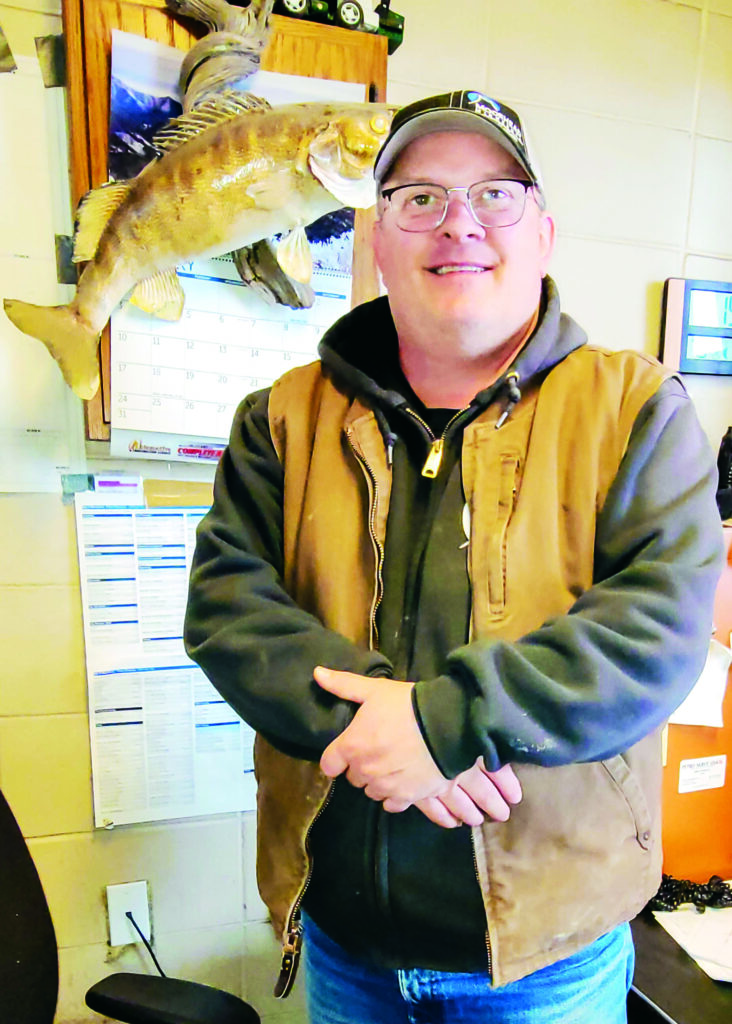
Todd Bratlien’s found “treasures” is the 10-pound walleye mounted on his office wall. There’s a story behind it. (Photo /Nancy Hanson.)
Nancy Edmonds Hanson
For some, it’s like Christmas without the ribbons. For the Moorhead sanitation workers whom Todd Bratlien supervises, the upcoming Cleanup Days tell a different story.
“I’ve seen it all. There’s nothing I haven’t seen,” says Bratlien, the city’s transfer plant supervisor. Sitting in his tiny, untidy office in Moorhead’s Solid Waste Transfer Station at 2727 Highway 10 East, he reflects on some of the hidden “treasures” uncovered on local curbs or brought directly for disposal by residents.
One of them looks over his shoulder as he sits at his desk. It’s a 10-pound walleye, somewhat the worse for wear. He rescued it when a Moorheader headed for Arizona brought it to be disposed of.
“He turned out to have been my Babe Ruth coach when I was 15,” Bratlien recalls. “We started talking, and he told me, ‘My dad and I caught that fish on 9-11. It was the only bite we had all day.’
“I asked him, don’t you want to give it to your kids? He didn’t. I kept it, and I’ll probably give them a call someday.”
Bratlien got a job as what he calls a “grunt laborer” at the plant shortly after graduating from high school in 1989. He worked on the trucks for more than 20 years before being named supervisor eight years ago. He manages a staff of 18.
The name of every homeowner’s favorite event has changed from Cleanup Week to Days because of the extended pickup schedule instituted in 2021. The event extends from May 2 through May 13 this year, two weeks of sequential pick-ups keyed to residents’ recycling schedules. Those who follow Recycling Week A will have their trash collected from the boulevards May 2-6; Schedule B are slated for May 9-13. No recycling bins will be emptied during a household’s Cleanup Day.
Like so many other adjustments, Moorhead can thank COVID-19 for the move from one to two weeks. In 2020, the trash festival was canceled altogether, with free drop-offs at the transfer station substituted that spring and fall. The two-week agenda was put in place in 2021 – a solution to concerns about the potential health risk of hiring day laborers to augment the regular staff. Spreading out the pickups also reduced huge spike in overtime of previous years, when sanitation workers regularly put in 20 to 30 extra hours.
“It worked great last year,” Bratlien reports. “I don’t know why we didn’t think of it sooner.”
The popularity of the city’s annual “gift” to people with cluttered garages and attics is absolutely clear. “Everyone loves free,” he grins. “In the old days, we’d pick up anything you set out at any time. Then the city went to volume-based collection about 30 years ago, and people had to pay for extra piles. Instead, they started saving it up all year in the garage and then putting it out at Cleanup Week – at no extra cost.”
Everybody does love free – including the scavengers who delight in scouring the streets for worthwhile finds. Bratlien divides them into two camps: the scrappers, who are searching for discarded appliances and electric cords that contain copper that they’ll sell by weight to Gerdau Metallics in Fargo; and the junkers, who dig through piles looking for whatever catches their eye.
“That’s fine, as long as they don’t leave a mess,” he says. Too many junkers, however, dig unreasonably deep. “If you put out trash in garbage bags, chances are you’ll find a hole slashed in them the next morning. That’s a lot of extra work for everybody.”
Not thrilled with strangers snooping through all the things you’ve tossed away? The transfer station will accept household discards at no charge during Cleanup Days. Normally there’s a modest charge for dropping off discards at the Highway 10 facility, but it’s free for the next two weeks.
Most of the refuse picked up by garbage trucks and the payloaders the Street Department calls into play for larger items ends up back at the transfer station. There, trucks are emptied onto the floor in the upper level, with their loads then pushed downstairs to be loaded into semi trailers bound for the Clay County Landfill.
Household waste is what Cleanup Days are all about. That includes most things, including up to two appliances per household. No commercial waste will be gathered. Nor will the scrap left after demolition or construction projects – by amateurs or companies – be collected during the event. Lumber, concrete sheet rock, fencing, windows, doors and asphalt shingles can be hauled to the transfer station of Clay Demolition Debris Landfill by the owner, where a fee will be charged.
A few of the ground rules have changed. Tires, for example, will not be picked up. Homeowners are encouraged to dispose of them at retail tire stores. Others are the same as before: Appliances containing Freon – refrigerators, freezers, air conditioners, dehumidifiers – will be collected separately to enable draining them of the environmentally hazardous gas.
Other hazardous garbage cannot be picked up; instead, owners can take it to collections sites themselves. Liquids like paint and other household chemicals must be sent to the Clay County Household Hazardous Waste Facility next door to the transfer station on Highway 10. Discarded electronics, including computers, monitors, TVs, fluorescent and LED bulbs, cell phones, rechargeable batters and strings of holiday lights go to Clay County Electronics Recycling at 1300 15th Ave. N.
Bratlien has a tip about handling those partial cans of paint so many homeowners squirrel away in garages. “Take the lid off and leave it for a month or so,” he suggests. “It’ll dry up, and then it’s solid waste. We can pick that up.”
He tells of some of the curbside surprises he’s witnessed. The weirdest, he suggests, was the pile of car parts. “It was basically a whole car, minus the engine and tires. We took it,” he says. Or then there was the boat – a whole, intact boat. “Too big. We couldn’t take that one … but a junk hunter came along and towed it away.”
And he and his crew do put some of their finds to use. Space is tight in the transfer station, so workers set up an unofficial fair-weather break room on the ramp outside. What do they sit on? Lawn chairs abandoned to their fate on a city’s worth of curbs.


